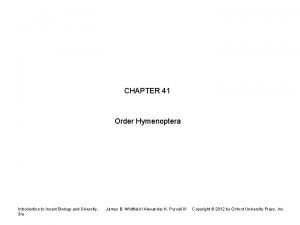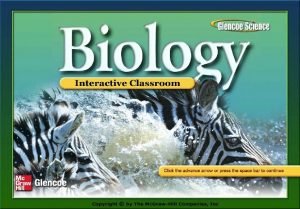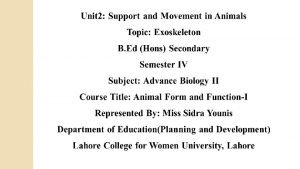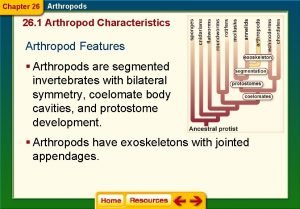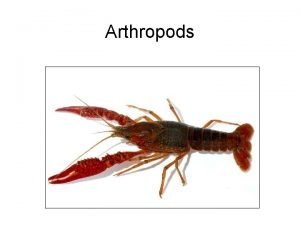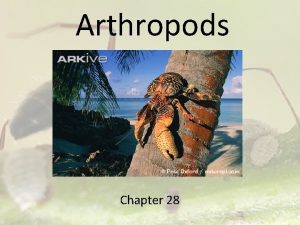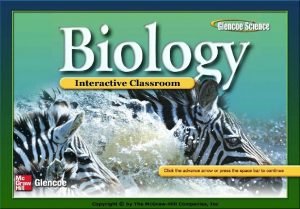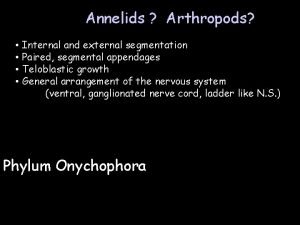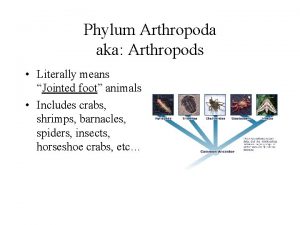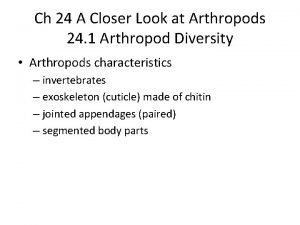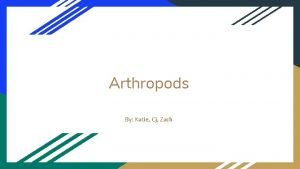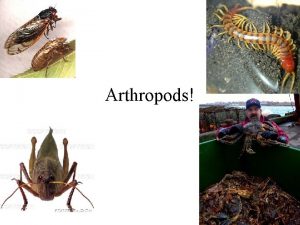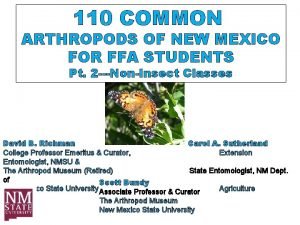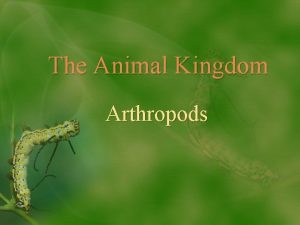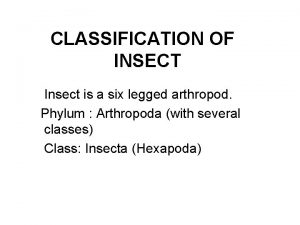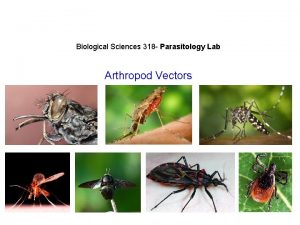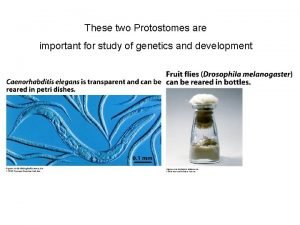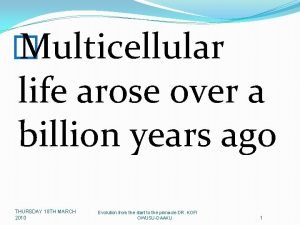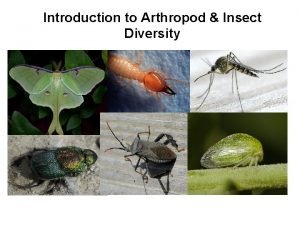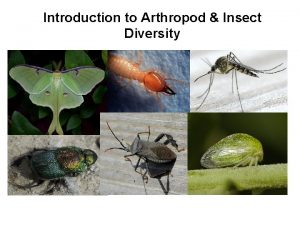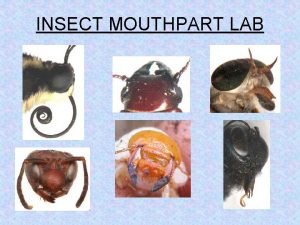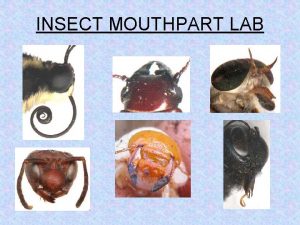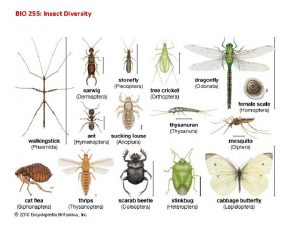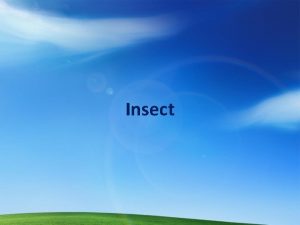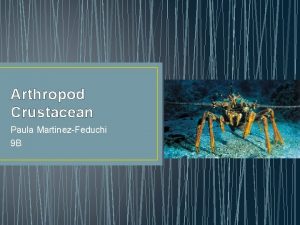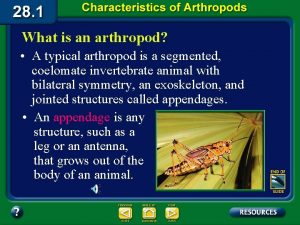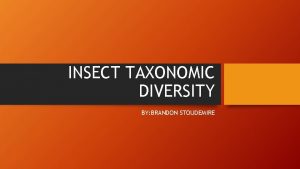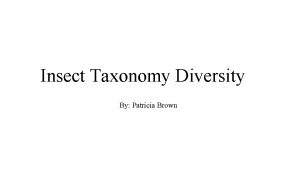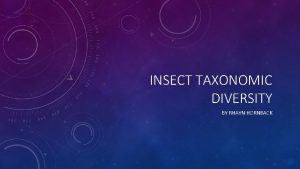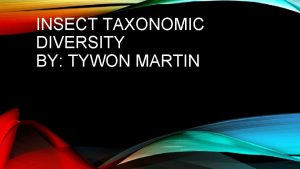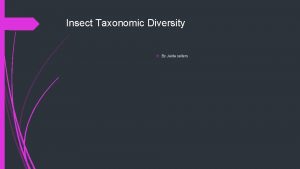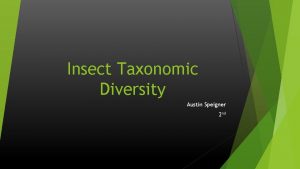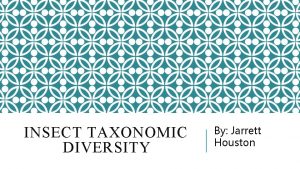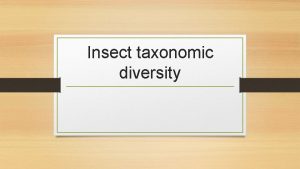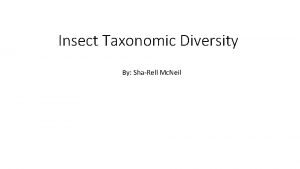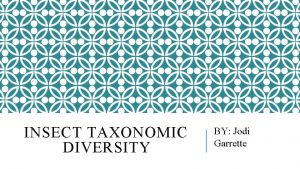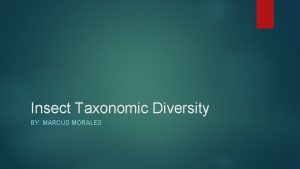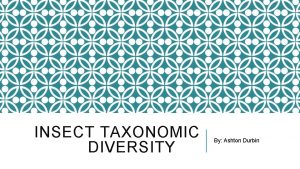Introduction to Arthropod Insect Diversity Scientific Classification Kingdom






























- Slides: 30

Introduction to Arthropod & Insect Diversity

Scientific Classification Kingdom General Division/Phylum Class Order Family Genus species specific

Scientific Classification in the Department of Education School System Science Level Characteristic For Classification DOE Level Kingdom All schools found on an island The island of Oahu Division/Phylum Complex Kaimuki Complex General specific

Scientific Classification in the Department of Education School System Science Level Characteristic For Classification DOE Level Kingdom All schools found on an island The island of Oahu Division/Phylum Complex Kaimuki Complex Class High schools in complex Kaimuki High Order Inter. schools in complex Washington Middle and Jarrett Middle Family Elem. schools in complex Ala Wai, Aliiolani, Hokulani, Jefferson, Kuhio, Lunalilo, and Palolo General specific

Scientific Classification in the Department of Education School System Science Level Characteristic For Classification DOE Level Kingdom All schools found on an island The island of Oahu Division/Phylum Complex Kaimuki Complex Class High schools in complex Kaimuki High Order Inter. schools in complex Washington Middle and Jarrett Middle Family Elem. schools in complex Ala Wai, Aliiolani, Hokulani, Jefferson, Kuhio, Lunalilo, and Palolo Genus A classroom in an elem. school B-121 at Hokulani A student in A-15 at Hokulani Student XYZ species General specific

Scientific Classification in the Department of Education School System Kingdom Class Genus General Phylum/Division Order Family species specific

Characteristics to classify organisms: CELL TYPE Prokaryotic cell type DNA is free floating Eukaryotic cell type DNA is surrounded by a membrane

Characteristics to classify organisms: NUMBER OF CELLS OR unicellular multicellular

Characteristics to classify organisms: MODE OF NUTRITION (how organisms eat) Photosynthesis: utilizing energy from the sun to produce food Engulfing: to flow over and enclose Absorbing: to suck up or take up (like a sponge)

KINGDOM CHART ANIMALIA Eukaryotic Multicellular Engulfing heterotrophs PLANTAE Eukaryotic Multicellular Photosynthetic autotrophs FUNGI Eukaryotic Multicellular Absorptive heterotrophs PROTISTA ARCHAEBACTERIA Prokaryotic Unicellular Found in very harsh conditions (i. e. bottom of the ocean or volcanic vents) Oldest living organisms Eukaryotic Unicellular or Multicellular Heterotrophs Photosynthetic autotrophs EUBACTERIA Prokaryotic Unicellular Found in neutral conditions (i. e. human body and food) Lactobacillus bulgaricus (or L. acidophilus) and Streptococcus thermophilus helps produces yogurt from milk

The Importance of Insects Some insects are beneficial: Pollinate flowers Balance Nature Important Products Research Some insects are harmful: Destroy food crops Stings & Bites Causes Sickness Money Loss

Insect Diversity • Insects have a long evolutionary history on earth • Insects live in every type of habitat (except the deep ocean) • Insects are the only invertebrates (animals without backbones) that can fly! • There are millions of insect species • Insects make up 85% of the entire animal kingdom!

Metamorphosis: A change in physical form The insect’s exoskeleton does not grow with them and must be shed and re-grown each time they get larger. COMPLETE CHANGE Monarch Caterpillar Monarch Butterfly small change Worker Termite Nymph

An insect has four characteristics: Dragonfly 1. Three body segments: Head , Thorax and Abdomen 2. One pair of antennae 3. Three pairs of legs (6 legs in total) 4. Usually 1 or 2 pairs of wings ABDOMEN: This body segment holds all reproductive organs. THORAX: The 3 pairs of legs and wings are attached to this body segment. HEAD: The eyes, antennae, and mouthparts are on the head.

Where do insects fit in the scientific classification picture? Kingdom Animalia Phylum Arthropoda General jointed foot segmented body exoskeleton (external skeleton) Class Insecta 6 legs 3 body parts (head, thorax, abdomen) 1 pair of antennae Wings (usually) specific Order

Order Diptera Flies and Mosquitoes Fruit Fly Mosquito Blow fly

Order Lepidoptera Butterflies and Moths Kameha Butterfly Blackburn’s Butterfly Monarch Caterpillar Luna Moth Monarch Butterfly

Order Odonata Dragonflies and Damselflies Dragonflies from the Alakai Swamp Trail, Kauai Native Hawaiian Damselflies

Order Coleoptera Beetles Lady Bugs Dung Beetle © 1997 -2002 Charles Le. Wallen Rainbow Scarab Beetle © 1997 -2002 Charles Le. Wallen

Order Isoptera Termites Queen Wood Damage Australian Termite Mound Workers & Soldiers

Order Hymenoptera Ants, Bees and Wasps Honey Bee © 1997 -2002 Charles Le. Wallen Carpenter Ant © 1997 -2002 Charles Le. Wallen Velvet Ant Yellow Jacket

Order Hemiptera or Order Heteroptera True Bugs © 1997 -2002 Charles Le. Wallen Stink Bug Leaf-footed Bug Spiny Assassin Bug © 1997 -2002 Charles Le. Wallen

Order Homoptera Cicadas, Hoppers, Psyllids, Whiteflies, Aphids, and Scale Insects © 1997 -2002 Charles Le. Wallen Buffalo Treehopper © 1997 -2002 Charles Le. Wallen Green Aphid © 1997 -2002 Charles Le. Wallen Periodical Cicada

Order Mantodea Praying Mantids © 1997 -2002 Charles Le. Wallen Green Mantid

Order Orthoptera Grasshoppers, Crickets and Katydids © 1997 -2002 Charles Le. Wallen Bird Grasshopper Cricket Narrow Winged Katydid

Order Phasmida Walking Sticks and Leaf Insects © 1997 -2002 Charles Le. Wallen Walking Stick © Iona Stewart 2000 Spiny Leaf Insect

Order Blattaria Cockroaches Cinereous Cockroach Madiera Cockroach

Below there are some pictures of some insects. Can you pick out the characteristics they all have in common?

Appearing below will be pictures of different arthropods. Some are insects and some are not. Armed with your new definition, can you pick out the non-insects?

Resources Pictures provided by – Charles Le. Wallen – www. biosurvey. ou. edu/okwild/misc/toc. html – Bishop Museum www. bishopmuseum. org/research/natsci/ento. html – Neil Reimer (Hawaii State Department of Agriculture) Other informative websites www. buginfo. com/bugs 2. cfm http: //ucdavis. edu/bohart. asp? s=kidscorner&f=orders www. eagle. ca/~matink/ www. ivyhall. district 96. k 12. il. us/4 th/insects/bugmenu. html http: //www. hear. org/starr/hiinsects/images/index. html
 Biology
Biology General characteristics of arthropods
General characteristics of arthropods Old kingdom middle kingdom new kingdom
Old kingdom middle kingdom new kingdom Nnn ruled
Nnn ruled Youtube egypt
Youtube egypt Capital of egypt during the old kingdom
Capital of egypt during the old kingdom Are insects in kingdom animalia
Are insects in kingdom animalia Genetic diversity vs species diversity
Genetic diversity vs species diversity Ecosystem jigsaw activity
Ecosystem jigsaw activity External skeleton animals
External skeleton animals Chapter 26 section 1 arthropod characteristics
Chapter 26 section 1 arthropod characteristics Appendages meaning in biology
Appendages meaning in biology Arthropods characteristics
Arthropods characteristics Chapter 26 section 1 arthropod characteristics
Chapter 26 section 1 arthropod characteristics Arthropods segmentation
Arthropods segmentation Classes in phylum arthropoda
Classes in phylum arthropoda Arthropods
Arthropods Arthropod
Arthropod Arthropod
Arthropod What do arthropods have in common
What do arthropods have in common Arthropod
Arthropod Embryo development
Embryo development 6 legged arthropod
6 legged arthropod Arthropod subkingdom
Arthropod subkingdom Protostomes are
Protostomes are Nervous system of grasshopper
Nervous system of grasshopper Arthropod groups
Arthropod groups Cool protists
Cool protists Plantae
Plantae Domain eukarya, kingdom fungi
Domain eukarya, kingdom fungi The odds and ends kingdom
The odds and ends kingdom
